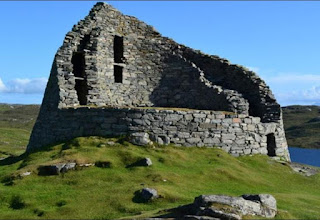We arrived on the Isle of Lewis around 6 a.m., precisely on
schedule, and tied up at the dock so that passengers could walk off the ship.
That we did with voyagers organized into six groups. We piled into three buses
in the morning, the same three in the afternoon, and everyone got a chance to
ride the island in a circle with no stress, no bother. Clockwork.
This was our Adventure Canada voyage around Scotland last June.
On our bus we had a wonderful guide named Doro,
short for Dorothea, who had an answer for every question, no matter how arcane.
The Dun Carlaway Broch dates from around the final century B.C., making it one
of the last to be built. It remained in use, probably as both castle and vertical
farmhouse, until the Vikings arrived in the early 800s. My favorite story
about the broch derives from the 16th century, when the Morrisons of
Ness took refuge here after getting caught raiding cattle from the local MacAulays.
The Morrisons blocked the broch entrance, which was designed for that purpose,
but Donald Cam MacAulay scrambled up the outer wall, threw down burning heather,
and forced the would-be thieves to stumble out to meet their fate.
The Callanish Stones are the largest assemblage
of such mystery objects in all Europe. Dating back 5200 years, they are not
only older than those at Stonehenge but are arranged in the shape of a Celtic
Cross and are also readily accessible. No cars roar past on nearby highways.
And if you have no fear of being shunted off backwards in time, Outlander-style,
you can reach out surreptitiously and touch them.
Even so, on Lewis, I got the biggest kick out of visiting the nine houses at the Gearrannan Blackhouse
Village, which hark back to the 17th century. Here we see how the vast
majority of Highlanders lived for centuries. The village highlight is the
working blackhouse, which has been reconstructed to the year 1955, when
inhabitants adapted and incorporated many of the features of the more modern
“white houses” that arose after the end of the Second World War. A local guide
named Mary, who was born and raised in this village, provided an evocative
depiction of life during this period of transformation.
Before leaving Lewis, passengers got to visit Stornoway.
Home to more than 7,000 people, it is by far the largest settlement in the Hebrides,
and offers a range of shops, services and amenities. Many passengers visited Lews
Castle and enjoyed its wooded walks and museum experience, which included
multi-media atmospherics and a collection of several of the original Lewis
Chessman. A bookstore on Cromwell Street enjoyed a run on Lewis-related books
by mystery writer Peter May . . . and on facsimile chessmen.









No comments:
Post a Comment